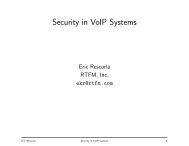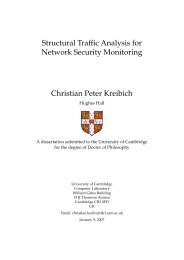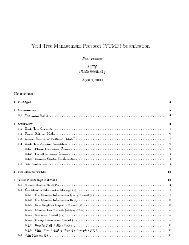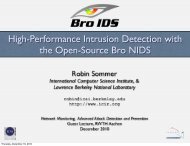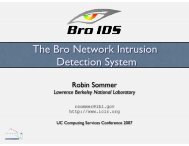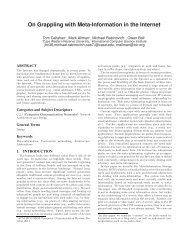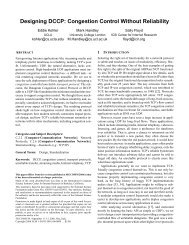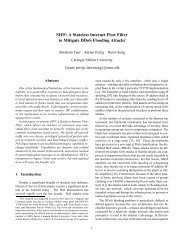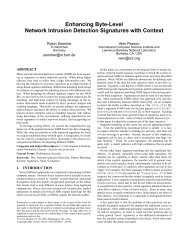Characteristics of Internet Background Radiation - UNC Computer ...
Characteristics of Internet Background Radiation - UNC Computer ...
Characteristics of Internet Background Radiation - UNC Computer ...
Create successful ePaper yourself
Turn your PDF publications into a flip-book with our unique Google optimized e-Paper software.
Effectiveness <strong>of</strong> Filter (% reduction in pkts or bytes)<br />
98<br />
96<br />
94<br />
92<br />
90<br />
Campus (pkts)<br />
Campus(bytes)<br />
LBL (pkts)<br />
LBL(bytes)<br />
5 10 15 20<br />
Filter Size (Number <strong>of</strong> Live Destination IPs per Source)<br />
Effectiveness <strong>of</strong> Filter (% reduction in pkts)<br />
100<br />
80<br />
60<br />
40<br />
20<br />
0<br />
Port 80 (HTTP)<br />
Port 135 (DCERPC)<br />
Port 139,445 (NetBIOS/SMB)<br />
Port 3127 (Mydoom)<br />
Others<br />
5 10 15 20<br />
Filter Size (Number <strong>of</strong> Live Destination IPs per Source)<br />
Figure 1: Effectiveness <strong>of</strong> Filtering, Networks (left) and Services (right)<br />
Source-Payload Filtering: This strategy keeps one instance <strong>of</strong><br />
each type <strong>of</strong> activity per source. From a data richness perspective,<br />
this seems quite attractive. However, it is very hard<br />
to implement in practice as we do not <strong>of</strong>ten know whether<br />
two activities are similar until we respond to several packets<br />
(especially true for multi-stage activities and chatty protocols<br />
like NetBIOS). This strategy also requires significant state.<br />
Source-Destination Filtering: This is the strategy we chose for<br />
our experiments, based on the assumption that background<br />
radiation sources possess the same degree <strong>of</strong> affinity to all<br />
monitored IP addresses. More specifically, if a source contacts<br />
a destination IP address displaying certain activity, we<br />
assume that we will see the same kind <strong>of</strong> activity on all other<br />
IP addresses that the source tries to contact. We find this<br />
assumption generally holds, except for the case <strong>of</strong> certain<br />
multi-vector worms that pick one exploit per IP address, for<br />
which we will identify only one <strong>of</strong> the attack vectors.<br />
Figure 1 illustrates the effectiveness <strong>of</strong> this filtering on different<br />
networks and services when run for a two-hour interval. The first<br />
plot shows that the filter reduces the inbound traffic by almost two<br />
orders <strong>of</strong> magnitude in both networks. The LBL network obtains<br />
more significant gains than the larger Campus networks because the<br />
Campus network intentionally does not respond to the last stage <strong>of</strong><br />
exploits from certain frequently-seen Welchia variants that in their<br />
last step send a large attack payload ( 30KB buffer overflow). The<br />
second plot illustrates the effectiveness <strong>of</strong> the filter for the various<br />
services. Since Blaster (port 135) and MyDoom (port 3127) scanners<br />
tend to horizontally sweep IP subnets, they lead to significant<br />
gains from filtering, while less energetic HTTP and NetBIOS scanners<br />
need to be nipped in the bud (low ¦ ) to have much benefit.<br />
3.1.2 Active Sink: an Event-driven Stateless Responder<br />
Platform<br />
Part <strong>of</strong> our active response framework explores a stateless approach<br />
to generating responses, with a goal <strong>of</strong> devising a highly<br />
scalable architecture. Active Sink is the active response component<br />
<strong>of</strong> iSink[42], a measurement system developed to scalably monitor<br />
background radiation observed in large IP address blocks. Active<br />
Sink simulates virtual machines at the network level, much like<br />
Honeyd [27], but to maximize scalability it is implemented in a<br />
stateless fashion as a Click kernel module [42] [16]. It achieves<br />
statelessness by using the form <strong>of</strong> incoming application traffic to<br />
determine an appropriate response (including appropriate sequence<br />
numbers), without maintaining any transport or application level<br />
state. A key question for this approach is whether all necessary<br />
responders can be constructed in such a stateless fashion. While<br />
exploring this issue is beyond the scope <strong>of</strong> the present work, we<br />
note that for all <strong>of</strong> the responders we discuss, we were able to implement<br />
a stateless form for Active Sink, as well as a stateful form<br />
based on Honeyd. (To facilitate the dual development, we developed<br />
interface modules so that each could use the same underlying<br />
code for the responders.)<br />
3.2 Application-Level Responders<br />
Our approach to building responders was “data driven”: we determined<br />
which responders to build based on observed traffic volumes.<br />
Our general strategy was to pick the most common form<br />
<strong>of</strong> traffic, build a responder for it detailed enough to differentiate<br />
the traffic into specific types <strong>of</strong> activity, and, once the “Unknown”<br />
category for that type <strong>of</strong> activity was sufficiently small, repeat the<br />
process with the next largest type <strong>of</strong> traffic.<br />
Using this process, we built an array <strong>of</strong> responders for the following<br />
protocols (Figure 2): HTTP (port 80), NetBIOS (port 137/139),<br />
CIFS/SMB [7] (port 139/445), DCE/RPC [10] (port 135/1025 and<br />
CIFS named pipes), and Dameware (port 6129). We also built<br />
responders to emulate the backdoors installed by MyDoom (port<br />
3127) and Beagle (port 2745) [5], [24].<br />
Application-level responders need to not only adhere to the structure<br />
<strong>of</strong> the underlying protocol, but also to know what to say. Most<br />
sources are probing for a particular implementation <strong>of</strong> a given protocol,<br />
and we need to emulate behavior <strong>of</strong> the target s<strong>of</strong>tware in<br />
order to keep the conversation going.<br />
The following example <strong>of</strong> HTTP/WebDAV demonstrates what<br />
this entails. We see frequent "GET /" requests on port 80. Only<br />
by responding to them and mimicking a Micros<strong>of</strong>t IIS with Web-<br />
DAV enabled will elicit further traffic from the sources. The full<br />
sequence plays as:<br />
GET<br />
<br />
/<br />
|200 OK ... Server: Micros<strong>of</strong>t-IIS/5.0|<br />
SEARCH /<br />
|411 Length Required|<br />
SEARCH /AAA... (URI length 30KB)<br />
(buffer overflow exploit received)<br />
Some types <strong>of</strong> activity require quite intricate responders. Many<br />
Micros<strong>of</strong>t Windows services run on top <strong>of</strong> CIFS (port 139/445),<br />
which lead us to develop the detailed set <strong>of</strong> responses shown in<br />
Figure 3. Requests on named pipes are further tunneled to various<br />
DCE/RPC responders. One <strong>of</strong> the most complicated activities<br />
is the exploit on the SAMR and later on the SRVSVC pipe,<br />
which involves more than ten rounds exchanging messages before<br />
the source will reveal its specific intent by attempting to create an<br />
executable file on the destination host. Figure 4 shows an example<br />
where we cannot classify the source until the “NT Create AndX”




